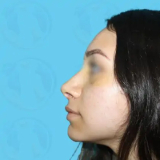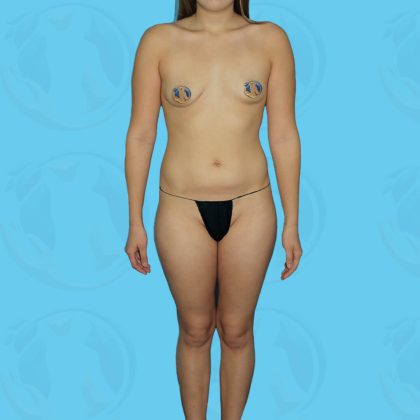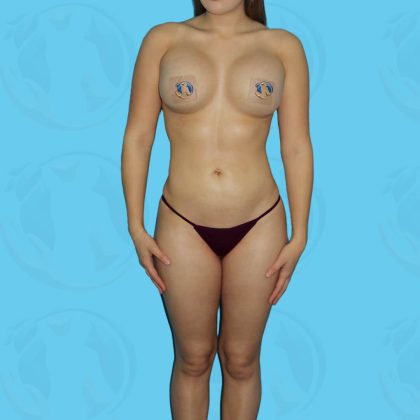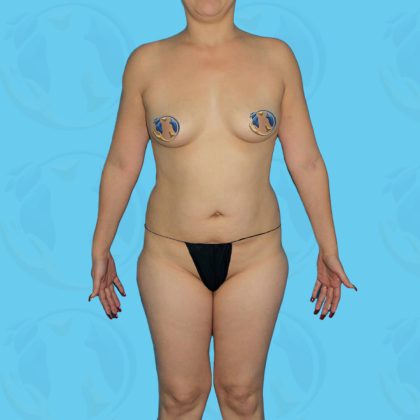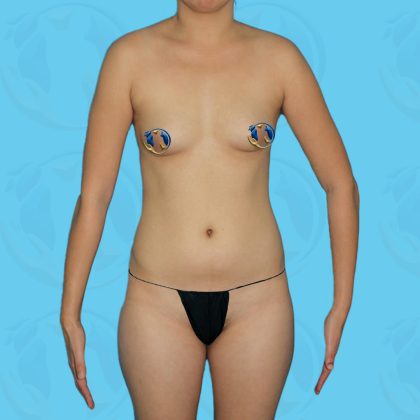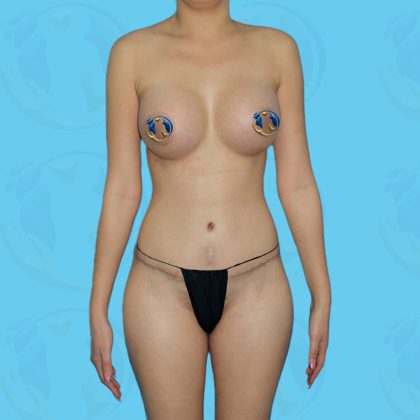Breast Augmentation
Conveniently located to serve the areas of Tijuana, Mexico

Breast augmentation is a surgical procedure to enhance the size and shape of a woman’s breasts. If you are considering breast augmentation, this section will give you a basic understanding of the procedure.
Before and After Photos
Contents
Key Benefits of Implants Surgery
Breast augmentation, technically known as augmentation mammoplasty, is a surgical procedure to enhance the size and shape of a woman’s breast for a number of reasons:
- To enhance the body contour of a woman who, for personal reasons, feels her breast size is too small.
- To correct a reduction in breast volume after pregnancy.
- To balance a difference in breast size.
- As a reconstructive technique following breast surgery.
- By inserting an implant behind each breast, surgeons are able to increase a woman’s bustline by one or more bra cup sizes.
If you’re considering breast augmentation, this will give you a basic understanding of the procedure — when it can help, how it’s performed, and what results you can expect. It can’t answer all of your questions, since a lot depends on your individual circumstances. Please ask your surgeon if there is anything you don’t understand about the procedure.
Ideal Candidates
Breast augmentation can enhance your appearance and your self-confidence, but it won’t necessarily change your looks to match your ideal, or cause other people to treat you differently. Before you decide to have surgery, think carefully about your expectations and discuss them with your surgeon.
The best candidates for breast augmentation are women who are looking for improvement, not perfection, in the way they look. If you’re physically healthy and realistic in your expectations, you may be a good candidate.
Consultation
In your initial consultation, your surgeon will evaluate your health and explain which surgical techniques are most appropriate for you, based on the condition of your breasts and skin tone. If your breasts are sagging, your doctor may also recommend a breast lift.
Be sure to discuss your expectations frankly with your surgeon. He or she should be equally frank with you, describing your alternatives and the risks and limitations of each. You may want to ask your surgeon for a copy of the manufacturer’s insert that comes with the implant he or she will use — just so you are fully informed about it. And, be sure to tell your surgeon if you smoke, and if you’re taking any medications, vitamins, or other drugs.
Your surgeon should also explain the type of anesthesia to be used, the type of facility where the surgery will be performed, and the costs involved. Because most insurance companies do not consider breast augmentation to be medically necessary, carriers generally do not cover the cost of this procedure.
Preparation
Your surgeon will give you instructions to prepare for surgery, including guidelines on eating and drinking, smoking, and taking or avoiding certain vitamins and medications. While making preparations, be sure to arrange for someone to drive you home after your surgery and to help you out for a few days, if needed.
Surgery Location
Your surgeon may prefer to perform the operation in an office facility, a freestanding surgery center, or a hospital outpatient facility. Occasionally, the surgery may be done as an inpatient in a hospital, in which case you can plan on staying for a day or two.
Types of Anesthesia
Breast augmentation can be performed with a general anesthesia, so you’ll sleep through the entire operation. Some surgeons may use a local anesthesia, combined with a sedative to make you drowsy, so you’ll be relaxed but awake, and may feel some discomfort.
Post-Procedure
You’re likely to feel tired and sore for a few days following your surgery, but you’ll be up and around in 24 to 48 hours. Most of your discomfort can be controlled by medication prescribed by your doctor. Within several days, the gauze dressings, if you have them, will be removed, and you may be given a surgical bra. You should wear it as directed by your surgeon. You may also experience a burning sensation in your nipples for about two weeks, but this will subside as bruising fades. Your stitches will come out in a week to 10 days, but the swelling in your breasts may take three to five weeks to disappear.
Getting Back to Normal
You should be able to return to work within a few days, depending on the level of activity required for your job. Follow your surgeon’s advice on when to begin exercises and normal activities. Your breasts will probably be sensitive to direct stimulation for two to three weeks, so you should avoid much physical contact. After that, breast contact is fine once your breasts are no longer sore, usually three to four weeks after surgery. Your scars will be firm and pink for at least six weeks. Then they may remain the same size for several months, or even appear to widen. After several months, your scars will begin to fade, although they will never disappear completely. Routine mammograms should be continued after breast augmentation for women who are in the appropriate age group, although the mammographic technician should use a special technique to assure that you get a reliable reading, as discussed earlier. (see All breast surgery carries some uncertainty and risk.)
Your New Look
For many women, the result of breast augmentation can be satisfying, even exhilarating, as they learn to appreciate their fuller appearance. Regular examination by your plastic surgeon and routine mammograms for those in the appropriate age groups at prescribed intervals will help assure that any complications, if they occur, can be detected early and treated. Your decision to have breast augmentation is a highly personal one that not everyone will understand. The important thing is how you feel about it. If you’ve met your goals, then your surgery is a success.
This surgery is a great option for women who have naturally small or asymmetrical breasts, who have lost breast volume after pregnancy or breastfeeding and want to restore a natural shape to the breasts.
See The Procedure In Action
FAQ
Who is candidate for breast augmentation ?
Breast augmentation can enhance your appearance and your self-confidence, but it won’t necessarily change your looks to match your ideal, or cause other people to treat you differently. Before you decide to have surgery, think carefully about your expectations and discuss them with your surgeon.
The best candidates for breast augmentation are women who are looking for improvement, not perfection, in the way they look. If you’re physically healthy and realistic in your expectations, you may be a good candidate.
What types of breast implants are there?
Breast implant is a silicone shell filled with either silicone gel or a salt-water solution known as saline.
Saline-filled implants continue to be available to breast augmentation patients on an unrestricted basis, pending further FDA review. You should ask your doctor more about the specifics of the FDA decisions.
Is there a risk?
All breast implant surgery carries some uncertainty and risk,
Breast augmentation is relatively straightforward. But as with any operation, there are risks associated with surgery and specific complications associated with this procedure.
The most common problem, capsular contracture, occurs if the scar or capsule around the implant begins to tighten. This squeezing of the soft implant can cause the breast to feel hard. Capsular contracture can be treated in several ways, and sometimes requires either removal or “scoring” of the scar tissue, or perhaps removal or replacement of the implant.
As with any surgical procedure, excessive bleeding following the operation may cause some swelling and pain. If excessive bleeding continues, another operation may be needed to control the bleeding and remove the accumulated blood.
A small percentage of women develop an infection around an implant. This may occur at any time, but is most often seen within a week after surgery. In some cases, the implant may need to be removed for several months until the infection clears. A new implant can then be inserted.
Some women report that their nipples become oversensitive, undersensitive, or even numb. You may also notice small patches of numbness near your incisions. These symptoms usually disappear within time, but may be permanent in some patients.
There is no evidence that breast implants will affect fertility, pregnancy, or your ability to nurse. If, however, you have nursed a baby within the year before augmentation, you may produce milk for a few days after surgery. This may cause some discomfort, but can be treated with medication prescribed by your doctor.
Occasionally, breast implants may break or leak. Rupture can occur as a result of injury or even from the normal compression and movement of your breast and implant, causing the man-made shell to leak. If a saline-filled implant breaks, the implant will deflate in a few hours and the salt water will be harmlessly absorbed by the body.
If a break occurs in a gel-filled implant, however, one of two things may occur. If the shell breaks but the scar capsule around the implant does not, you may not detect any change. If the scar also breaks or tears, especially following extreme pressure, silicone gel may move into surrounding tissue. The gel may collect in the breast and cause a new scar to form around it, or it may migrate to another area of the body. There may be a change in the shape or firmness of the breast. Both types of breaks may require a second operation and replacement of the leaking implant. In some cases, it may not be possible to remove all of the silicone gel in the breast tissue if a rupture should occur.
A few women with breast implants have reported symptoms similar to diseases of the immune system, such as scleroderma and other arthritis-like conditions. These symptoms may include joint pain or swelling, fever, fatigue, or breast pain. Research has found no clear link between silicone breast implants and the symptoms of what doctors refer to as “connective-tissue disorders,” but the FDA has requested further study.
While there is no evidence that breast implants cause breast cancer, they may change the way mammography is done to detect cancer. When you request a routine mammogram, be sure to go to a radiology center where technicians are experienced in the special techniques required to get a reliable x-ray of a breast with an implant. Additional views will be required. Ultrasound examinations may be of benefit in some women with implants to detect breast lumps or to evaluate the implant.
While the majority of women do not experience these complications, you should discuss each of them with your physician to make sure you understand the risks and consequences of breast augmentation.
Contact
We’re only 2 minutes away from the US border, book now and save up to 60% on your procedure, (Compared to most US plastic cosmetic surgeons).



